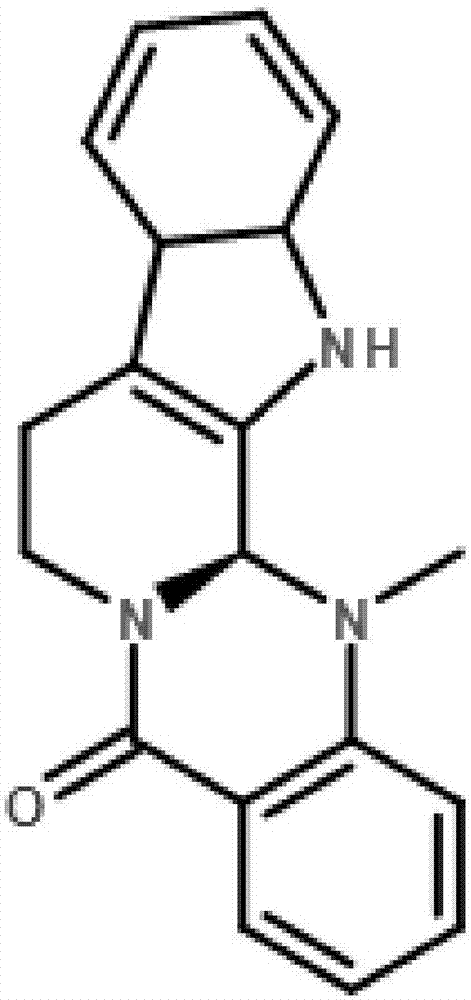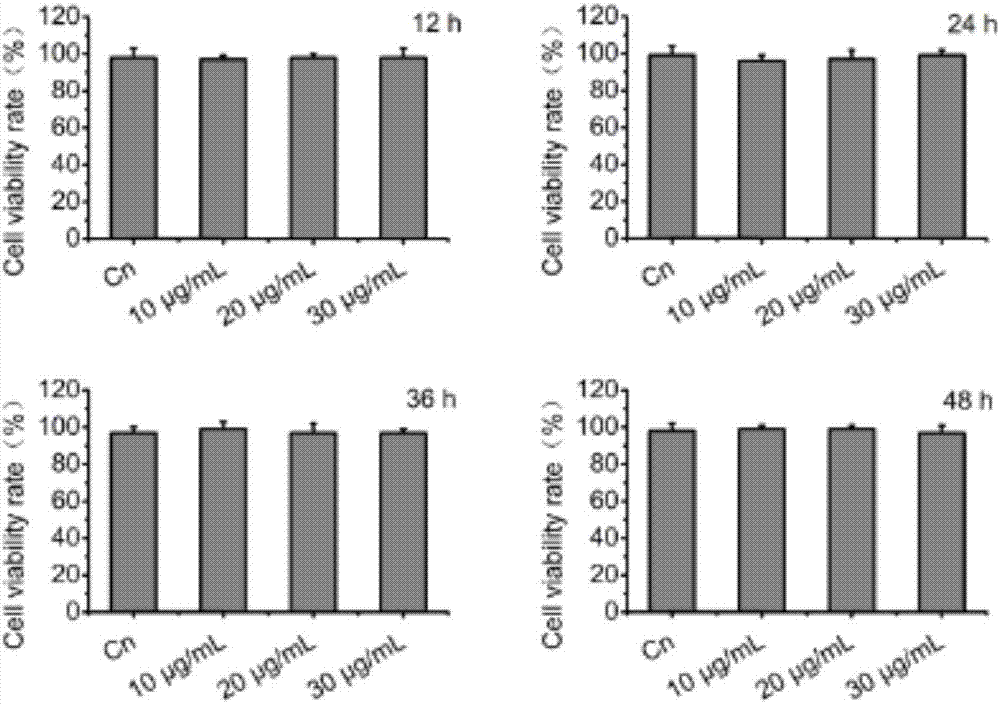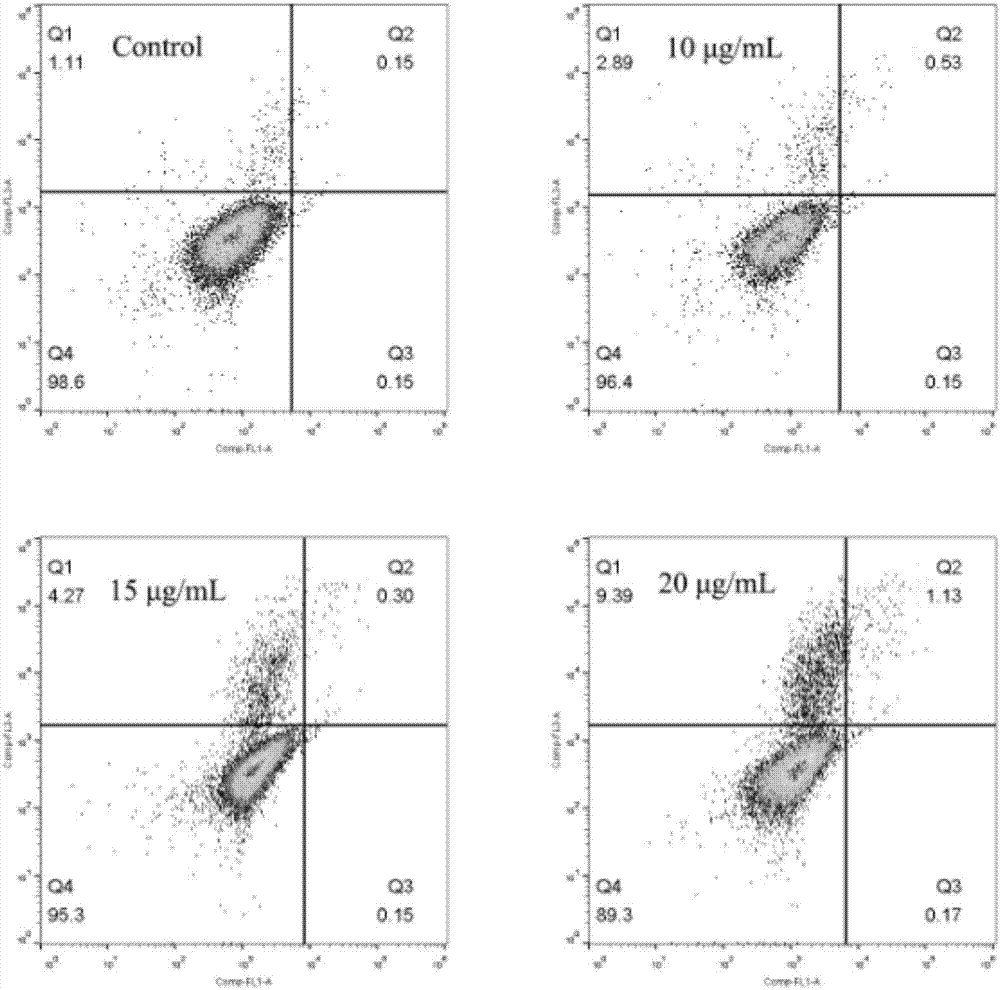Application of evodiamine in preparation of anti-osteoporosis drug and anti-osteoporosis drug
An anti-osteoporosis and evodiamine technology, applied in the field of biomedicine, can solve problems such as adverse reactions and increased risk of breast cancer, and achieve the effects of inhibiting bone resorption, alleviating adverse reactions, and promoting bone formation.
- Summary
- Abstract
- Description
- Claims
- Application Information
AI Technical Summary
Problems solved by technology
Method used
Image
Examples
Embodiment 1
[0047] Embodiment 1 evodiamine ( figure 1 ) toxicity to mouse bone marrow macrophages
[0048] In order to show that the inhibitory effect of evodiamine on osteoclast differentiation of the present invention is not caused by the cytotoxicity of evodiamine, the MTT test is carried out on mouse bone marrow macrophages with evodiamine, and the apoptosis of cells is tested by flow cytometry. Mortality.
[0049] 1. MTT test (thiazolium blue colorimetric method):
[0050] Mouse bone marrow macrophages were cultured using conventional experimental methods, and then the mouse bone marrow macrophages were cultured at 1×10 4 Each cell / cell was seeded in a 96-well plate, and the medium was discarded after the cells were overgrown, and evodiamine was added to each fresh medium at a final concentration of 0 (Control), 10 μg / mL, 20 μg / mL and 30 μg / mL, respectively. Then add to the 96-well plate, then, use the MTT assay method to evaluate the inhibitory effect of evodiamine on the prolife...
Embodiment 2
[0053] Example 2 Evodiamine can inhibit the differentiation of hematopoietic stem cells into osteoclasts
[0054] According to research findings, mouse bone marrow macrophages can differentiate into osteoclasts under the stimulation of nuclear factor receptor activator ligand RANKL and human macrophage colony-stimulating factor. Osteoporosis is often caused by excessive bone resorption as a result of overactivation of osteoclasts.
[0055] Therefore, mouse bone marrow macrophages are selected as the cell model to study the effect of evodiamine on RANKL-induced osteoclastogenesis is very suitable. To observe whether evodiamine can inhibit the expression of specific genes related to osteoclasts and its effect on the osteophagy ability of osteoclasts, so as to illustrate the application and mechanism of evodiamine in the preparation of drugs for preventing and treating osteoporosis.
[0056] In order to show that evodiamine of the present invention can inhibit the differentiatio...
Embodiment 3
[0059] Example 3 Evodiamine can inhibit the expression of osteoclast formation transcription factors
[0060] In order to show that evodiamine can effectively inhibit the expression of transcription factors c-FOS and NFATc1 in osteoclast formation, mouse bone marrow macrophages were injected at 1×10 4 Each cell / cell was seeded in a 96-well plate, and the medium was discarded after the cells were overgrown, and evodiamine with a final concentration of 0 μg / mL, 5 μg / mL, 10 μg / mL and 15 μg / mL was added to each fresh medium, and then Added to the 96-well plate, while RANKL (75ng / mL) induced mouse bone marrow macrophages to differentiate into osteoclasts. Subsequently, the expression of the transcription factors c-FOS and NFATc1 of osteoclast formation was analyzed by electrophoresis ( Figure 8 ), GAPDH (glyceraldehyde-3-phosphate dehydrogenase) was used as a control group. Experiments showed that with the increase of evodiamine concentration, its inhibitory effect on the expres...
PUM
 Login to View More
Login to View More Abstract
Description
Claims
Application Information
 Login to View More
Login to View More - R&D
- Intellectual Property
- Life Sciences
- Materials
- Tech Scout
- Unparalleled Data Quality
- Higher Quality Content
- 60% Fewer Hallucinations
Browse by: Latest US Patents, China's latest patents, Technical Efficacy Thesaurus, Application Domain, Technology Topic, Popular Technical Reports.
© 2025 PatSnap. All rights reserved.Legal|Privacy policy|Modern Slavery Act Transparency Statement|Sitemap|About US| Contact US: help@patsnap.com



